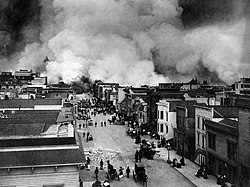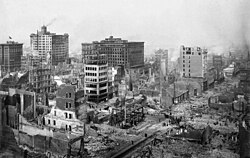Old Halith
(Old) Halith | |
|---|---|
Abandoned city | |
 A street in Old Halith, c. 1880 | |
| Country | Trellin |
| Province | Rezat |
| Founded | 1740 |
| Made provincial capital | 1869 |
| Status transferred to New Halith | 1883 |
Old Halith, known as Halith before its abandonment in the late nineteenth century, was the provincial capital of Rezat, in southern Trellin, from 1869 until 1883. It was first established in the mid-eighteenth century as a farming town at the centre of the fertile floodplain of the Etsakha, and its population remained relatively low for over a century. During the Rezati Silver Rush, which began in 1849, the population exploded to nearly 300,000 by 1883. Nearly a tenth of its population was foreign-born, an exceptionally high figure for a city in the inward-looking Trellinese Empire. Halith's growth was so dramatic that the seat of provincial government was transferred from Arkhal, which had been the centre of Trellinese power in Rezat for over a thousand years, to the young boomtown.
A string of events on 17 July 1883 led to an episode known as the Halith Disaster, in which the city was destroyed by a combination of floods, explosions, sinkholes and firestorm. The destruction was so complete that Old Halith was formally abandoned and the government moved to a new settlement that was dubbed New Halith (modern Halith). The ruins of Old Halith were designated a heritage area in 2015.
History
Settlement
Halith originated as a farmstead near the Etsakha, the chief river of central Rezat, on its rich alluvial floodplain. The first landowners included the Alkron and Baren families of Arimathea and Morikz, who established cattle-ranches in the fertile grasslands. Subsequent settlers established more ranches and grain farms and a town centre began to coalesce by the 1760s. For most of its early history, Halith existed mostly to cater to the farmers of an extensive hinterland in central Rezat. A further significance that it gained was as a river port for mines in the Prosperity Hills, where the Buloth, a tributary of the Etsakha, rises.
Silver rush boomtown
The discovery of silver in the Prosperity Hills in 1849 changed the fortunes of the entire provincial mainland. Thousands, then tens of thousands, flocked to the interior of an otherwise empty region from across Trellin and from further afield. In 1850 there were about 600 people living in Halith. By 1860 there were about 106,000. The Rezati government was initially overwhelmed and Halith and other settlements, like Kalku upriver, were inundated with vastly more people than could be housed. Tent cities sprang up in several areas, and entrepreneurs and con artists alike earned fortunes selling accommodation at inflated prices. As the government came to grips with the problem in the middle of the decade, ramshackle dwelling places were demolished to make way for a grand city arranged on a grid. The silver rush continued in full swing, and business interests convinced the provincial government to move its seat from Arkhal, the second largest city on the island of Morikz off the Rezati mainland, to Halith. Plans for a new city hall were drawn up in 1868 and the government was transferred under royal authorisation in 1869.
Halith's wealth and newness created the perfect conditions for the introduction of novelties like publicly-maintained networks of street lighting and gas mains. These gas mains were carried by an extensive system of underground tunnels dug through the floodplain's soft soil, but this project was still ongoing by the time of the city's abandonment. Indeed, the failure to complete and seal tunnels near the river was a critical factor in the events that would lead to Halith's destruction.
The rapid growth of Halith and other cities across the south spurred severe social issues which led ultimately to the General Insurrection of 1859. This was a major army mutiny especially in the provinces of Bal Emrith, Rezat and Mëhidan. Halith was relatively quiet during the insurrection, but a reform of the imperial military in its wake led to the establishment of an Artillery Corps base in the city. Halith became the site of a large ammunition dump and armoury, where thousands of tons of ammunition and explosives were stored in a cluster of wood and brick structures on the north side of the city.
Destruction of Halith
Halith was ill-prepared for the floods of the 1883 monsoon season, which brought unusually heavy rains to the southern provinces. Plans to build a dyke beside the shallow river were postponed, and only a wall of thirty thousand sandbags and shovelled earth lay between the city and the swollen Etsakha at dawn on 17 July. Floodwaters penetrated into the tunnels that carried the gas mains and from there rapidly eroded the soft soil on which Halith was built. Sinkholes developed across the city, and one swallowed the Artillery Corps armoury, causing a terrific explosion that killed most of the garrison and another two hundred citizens. Volunteer fire brigades responded quickly and rescued a handful of survivors. The city's network of gas mains was compromised by the ensuing disaster, and much of Halith was consumed by a firestorm that was developing rapidly just an hour after dawn. Only one hour later, those organising the defense of the city ordered its evacuation.
Aid poured in from across the province and indeed across western Astyria in the wake of the disaster, as the city's refugees were established on a ridge, Oret Natiin, overlooking the ruins. The Royal Society of Medics and Astyrian Federation of Red Cross Societies were both active in providing and distributing aid. Over a thousand people are believed to have died in the disaster, which also caused roughly 200 million NSD (5 billion NSD today) in property damage. It was, and remains, the most deadly and destructive natural disaster in Rezati history.
Abandonment
The destruction in the city was so complete that councillors voted to abandon the city and refound it in a safer location. They were slow to do so, however, as they feared that the title of provincial capital might revert to Arkhal if there was a break in Halith's continuity. They eventually secured from the royal inquiry into the disaster a guarantee that this would not happen as long as they had a new permanent meeting place within six months. Ground was broken for New Halith and work began on a city hall on 21 November 1883, on an updated version of the plans for Old Halith's city hall, while the new city was laid out to the same plan as the old and borrowed many of its streetnames.
Old Halith was thus stripped of any formal status. Very few of its citizens chose to return, and in any case the provincial government forbade residence in the ruins shortly afterward, which sped its decline into a ghost town. By 1890, Old Halith was officially uninhabited. An embankment was erected between Old Halith and the river in 1920 to protect what remained of the city from further destruction. Although it is officially deemed "dangerously unsafe," Old Halith is a popular location for urban exploration. In 2015, plans to demolish some of the most dangerous ruins met with public outcry, and the provincial government designated it a heritage area.

